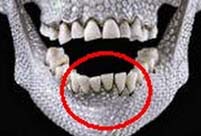 Amazing cliff diving in cold winter
Amazing cliff diving in cold winter
 Enjoy Sochi 2014 in slow motion
Enjoy Sochi 2014 in slow motion
 University student sentenced to death for poisoning roommate
University student sentenced to death for poisoning roommate
 Chinese lunar New Year celebrated in San Francisco
Chinese lunar New Year celebrated in San Francisco
 Taiwan Lantern Festival 2014
Taiwan Lantern Festival 2014
 Haiyang Yangge: make up
Haiyang Yangge: make up
 China's top 10 richest cities
China's top 10 richest cities
 President Xi visits garrison troops in Inner Mongolia
President Xi visits garrison troops in Inner Mongolia
 Turnip sculptures amaze tourists in Qingdao
Turnip sculptures amaze tourists in QingdaoBEIJING, Feb. 20 -- The value of the Chinese currency Renminbi, or the yuan, weakened 43 basis points to 6.1146 against the U.S. dollar on Thursday, according to the China Foreign Exchange Trading System.
It marked the third straight day the central parity rate of the yuan has fallen against the greenback. It fell 20 basis points on Tuesday and dipped another 30 points on Wednesday.
Thursday's exchange rate also marked a lowest reading against the dollar since the beginning of the year, even though the yuan surged to a historical high of 6.093 against the U.S. currency on Jan. 14.
Analysts said the recent decline of the yuan concurred with big banks' buying of foreign exchanges amid concerns of an economic slowdown, as investors, who used to be overly optimistic on the yuan's appreciation, are starting to restructure strategies.
Chinese economic growth eased to 7.7 percent in 2013 compared to 7.8 percent in 2012. A report released by Xiamen University on Thursday forecast growth will further slow to 7.62 percent in 2014.
Leading economic indicators such as the purchasing managers' index for the manufacturing sector, dropped to a six-month low of 50.5 percent in January, marking a bumpy start for the Chinese economy in 2014.
Lian Ping, chief economist at the Bank of Communications, said that China's foreign trade looks to turn more balanced, which will put less pressure on the yuan's appreciation. Meanwhile, the United States' tapering of its quantitative easing also does not support the continuous and sharp gains of the yuan.
Zong Liang, an international finance researcher at Bank of China, said that capital is flowing back to developed markets from emerging markets, after the U.S. started to wind down assets purchase by 10 billion U.S. dollars each month starting in January.
Zong said that the QE tapering has led to sharper fluctuations of exchanges rates in emerging markets, and also brought about depreciation expectations of the yuan.
The Philippine's central bank said on Saturday that the Fed's decision resulted in a massive outflow of foreign portfolio investment from the country in January as "investors started to divert funds back to the U.S.".
However, analysts said the tapering may also prove a valuable opportunity for China to progress reforms of the yuan's exchange rate regime.
China's central bank announced in mid-2010 that it would further promote the reform of the RMB (yuan) exchange rate regime and increase the flexibility of the RMB exchange rate.
The Chinese central bank also said on Wednesday that it will gradually improve the yuan exchange rate formation mechanism and widen the bands for the yuan's floating.
In China's foreign exchange spot market, the yuan is allowed to rise or fall by 1 percent from the central parity rate each trading day.
The central parity rate of the yuan against the U.S. dollar is based on a weighted average of prices before the opening of the market each business day.
 Most gorgeous female celebs in Chi-pao
Most gorgeous female celebs in Chi-pao Second round of test kicks off at Beijing Film Academy
Second round of test kicks off at Beijing Film Academy Ancient Qiang people had vertically grown teeth
Ancient Qiang people had vertically grown teeth Top 10 Chinese youth’s favorite seaside destinations
Top 10 Chinese youth’s favorite seaside destinations Traditional Tibetan clothing tailors
Traditional Tibetan clothing tailors In photos: Unveiling Taishan station
In photos: Unveiling Taishan station Beautiful moments of family reunion
Beautiful moments of family reunion 10 Valentine's Day ideas for couples
10 Valentine's Day ideas for couples Let's get married today!
Let's get married today! Chinese warplanes C919 to appear at Singapore Airshow 2014
Chinese warplanes C919 to appear at Singapore Airshow 2014 Ruins of Shang Dynasty's structure unearthed in Shaanxi
Ruins of Shang Dynasty's structure unearthed in Shaanxi  Intercity high speed train in operation
Intercity high speed train in operation Severe coldness freezes large parts of China
Severe coldness freezes large parts of China  Beautiful moments of Sochi
Beautiful moments of Sochi  It's not just performing this year
It's not just performing this yearDay|Week|Month